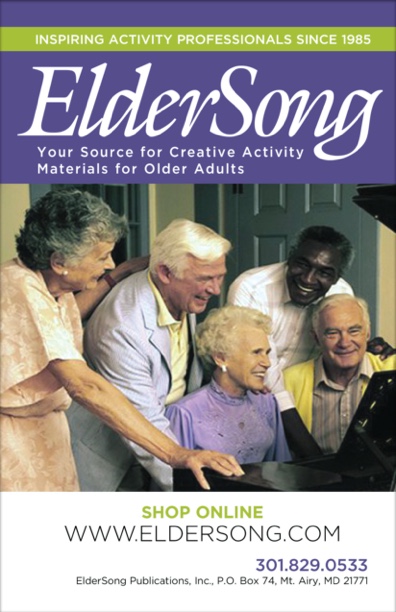Whether it’s the pleasant aromas of Thanksgiving dinner baking in the oven, or the familiar laughter of extended family as they regale with family tales, Thanksgiving holds a vast array of memories. Use this month to encourage your group to slow down and be grateful. Ready your group’s hearts, minds, and stomachs for Thanksgiving with the activity ideas below.
GRATITUDE JAR – Give each member a small mason jar or similar container at the start of the month. Encourage them to write one thing they are thankful for on a piece of paper and place inside their jars each day of the month. Gather at the end of the month and ask members to share what they recorded.
THANKSGIVING FOODS REMINISCENCE – Lead your group in a Thanksgiving foods reminiscence activity. Ask members to share their favorite Thanksgiving dishes and what memories those foods hold for them. Can they smell the turkey roasting in the oven? Who was busy cooking in the kitchen? What was their first Thanksgiving like as an adult? With whom did they usually spend the holiday? Are there any traditional Thanksgiving foods they dislike? Ask members to share their Thanksgiving traditions.
TURKEY BASTER FOOSBALL – You’ll need six turkey basters, a long table, masking tape, and a craft feather to play this kitchen utensil version of foosball. Prior to the game, arrange the long table in the middle of the room. Use masking tape to mark a goal on each end of the table. Set a chair at the head and the foot of the table, with two chairs on each long side of the table. Divide your head or foot of the table. One team sits on one side of the table, the other team sits on the opposite side. Give each participant a baster. Place a feather in the middle of the table. When you say “go” players use their basters to move the feather around the table. The team to score the most goals at the end of ten minutes wins. After ten minutes, rotate players so that other members can participate.
LESSONS FROM THE KITCHEN – Gather your group to discuss lessons they learned from their relatives while cooking in the kitchen. Who taught them how to cook? What were some of the first meals they learned to prepare? Did anything disastrous ever happen in the kitchen? Were family recipes passed down to the next generation in their family? How has cooking changed over the years? What important life lessons did they learn in the kitchen? Bring aprons and other kitchen utensils as props and use to spark conversation.
RECIPE TRANSFER CRAFT – These adorable tea towels are a fun way to preserve family recipes and make a wonderful gift. Follow the instructions provided by Mary’s Kitchen Flour Sack Towels. If participants don’t have any handwritten recipes, give them an index card and pen prior to the activity. Ask them to record their favorite recipe and bring it with them.
THANKSGIVING FOODS AROUND THE COUNTRY – Discuss regional Thanksgiving foods around the country with your group. For example, New Yorkers and New Jerseyites may serve manicotti, while someone from Maryland may include crab cakes on their menu. Frog eye salad is a must-have for some people from the West and Southwest. It’s not Thanksgiving in the Midwest without green bean casserole. Look up other popular regional Thanksgiving foods and discuss what’s most popular where you live.
KITCHEN UTENSILS MEMORY GAME – Prior to the activity, place a variety of kitchen utensils on a tray and cover with a tea towel. Gather your group and give each participant a piece of paper and a pencil. Tell participants there are kitchen utensils on a tray. In a moment, you will reveal these items and give them one minute to study the tray. All participants must refrain from writing anything down until the minute is complete. After the minute, recover the tray and instruct participants to write as many objects as they can recall on their paper. Afterwards, reveal each item on the tray. Participants can review their list and see how many items they accurately recalled. Alternatively, work as a large group and ask participants to call out the items while you record them on a white board.
PUMPKIN PIE IN A CUP – You’ll need a cup and a spoon for each participant, individually packaged vanilla pudding cups, graham crackers, sandwich-sized Ziploc bags, pumpkin pie puree, whipped cream, and cinnamon to create this delicious treat. Give each participant two graham crackers and instruct them to place the cracker inside the Ziploc bags. Seal tightly, then ask participants to smash the crackers into crumbs. Once smashed, participants pour the graham cracker crumbs into the bottom of their cups. Next, instruct participants to open the vanilla pudding cups and pour on top of the graham cracker crumbs. Add a scoop of pumpkin pie puree on top of the vanilla. Participants can mix the vanilla pudding and pumpkin puree if they desire. Top each cup with a dollop of whipped cream, sprinkle with a dash of cinnamon, and eat!
MODERN KITCHEN INVENTIONS – Reminisce with your group about how kitchen appliances have changed over the years. For example, prior to the invention of the microwave in 1946, it took much longer to reheat food. Cast iron ovens relied on a wood fire. Refrigerators weren’t nearly as big as they are today. Dishes were washed by hand, not by machine. Head over to House Beautiful for a fun slideshow about the American Kitchen.
SWEET OR SOUR? – Purchase a variety of flavorful foods for this fun taste-guess activity. Place one serving of each food in a cupcake liner for an easy way to serve participants. Once your group is gathered, give each participant the same food sample. They can smell and look at the sample. Have them guess if it will be sweet or sour. Then, let them taste. Were they correct? Continue until each item has been tasted. Suggested foods include Sour Patch Kids, chocolate chips, vinegar-flavored potato chips, Goldfish crackers, lemon drops, and marshmallows.
SPICY PAINTING – Spice up your next art class by infusing your tempera paints with a dash of spice. Give each participant five plastic cups and squirt a dollop of paint (different colors) into each cup. Ask them to choose a different spice to mix into each of their paint cups. For example, they might mix a dash of cinnamon into their red paint or turmeric into their orange paint. Use a plastic spoon to mix the spices into the paint. Once participants have created their spicy paints, they can paint their work of art.
COOKING SHOWS – Feature reruns of your group’s favorite cooking shows in the late afternoon or evening. Find DVDs at your local library, such as The French Chef or The Great British Baking Show. Reminisce with your group about their memories or discuss their favorite recipes featured on the shows.
RECIPES & REMINISCENCE TRIVIA
- Which popular Thanksgiving dish, featuring cream of mushroom soup as one of its six ingredients, was created by a Campbell’s Soup employee? Green bean casserole
- Whether you call it dressing or stuffing depends on what two reasons? How it’s prepared or where you live (Southerners generally call it “dressing,” people from the north and west call it “stuffing.”)
- What modern Thanksgiving dish calls for a chicken and duck to be stuffed inside a turkey? The turducken
- It would not be Thanksgiving Day for most people without which traditional dessert? Pumpkin pie
- Which U.S. president made Thanksgiving a national holiday? Abraham Lincoln
- Which U.S. state provides the most turkeys each year: Minnesota, Wisconsin, or Iowa? Minnesota
- Because they had 260 tons of extra turkey one year, Swanson is credited with inventing what type of meal that’s packaged with other sides? Frozen dinner meals
- Which ingredient makes a soufflé rise? Egg
- Who revolutionized American cuisine through her French cooking school, award-winning cookbooks, and world-renowned cooking television programs? Julia Child
- What protective garment is often worn while preparing food? An apron
RECIPES & REMINISCENCE THOUGHT FOR THE MONTH
“A recipe has no soul. You, as the cook, must bring soul to the recipe.” ~ Thomas Keller
“Recipes & Reminiscence” was written by Erin McCart. Copyright 2021 ElderSong Publications, Inc. All rights reserved. Reprint Policy: To reprint or republish all or portions of this entry, please acquire written permission and agree to link back to the original source. You can contact us at [email protected] to obtain permission.


